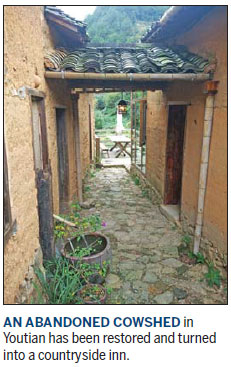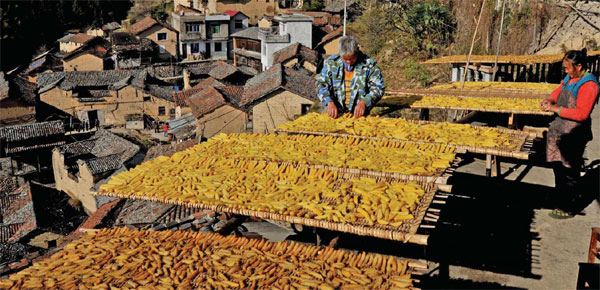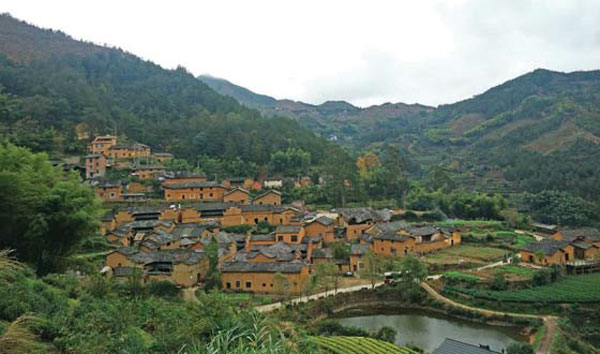Village revival

A county in East China is part of an effort to save centuries-old houses before they succumb to modern pressures
Songyang does not even have a taxi. Located in Lishui, Zhejiang province, the county of 240,000 population is the exception in East China.
Thanks to its well-preserved old villages, its people call their hometown the best kept secret in Jiangnan, a term used to describe the area south of Yangtze River, one of China's most developed regions.
Youtian village in Songyang has 312 registered residents. Its few old houses with yellow earthen walls and black tiles point to its centuries-old history. Today, about 10 old structures remain in the village, having withstood the vicissitudes of nature for about 500 years.
| Villagers dry newly harvested sweet potatoes under the sun in Youtian village in Lishui, Zhejiang province. Photos by Wang Kaihao / China Daily |
| Youtian village has a history of more than 500 years and is now on the national list of "traditional Chinese villages". |
"Traditional landscapes cannot be allowed to be destroyed by urban lifestyles," says Ye Lianhan, head of the village committee.
"There are new houses amid the old ones, but we have reconstructed their roofs and repainted their walls to make them blend in."
Once upon a time, Ye and other residents were faced with the dilemma of how to deal with the crumbling of many old houses.
"We feel terrible to see the old houses collapse," he says. "They belong to our ancestors, so we wanted to ensure that they don't become ruins."
But the residents did not have enough money to renovate, and local cultural authorities were reluctant to finance the restoration of privately owned property.
Fortunately, a trial project was launched in 2015 to save the houses before they fell apart.
The China Foundation for Cultural Heritage Conservation, a Beijing-based public fund, offered an option to the villagers to renew their homes.
"We were provided with half the money we needed to restore the houses, and the rest we managed ourselves," Ye says. "The villagers decided how to use their houses in the future, and renovation plans were adjusted accordingly."
Fifty villages in Songyang, including Youtian, are now on a national list of Traditional Chinese Villages. This puts it at the top of county-level administrative regions in East China, and there are still dozens of similar villages that have not made the list yet.
Meanwhile, the foundation plans to spend 40 million yuan ($5.8 million; 5.5 million euros; 4.6 million) in Songyang on the renovation of other houses in the area.
The county has also set up a special administrative office to supervise the use of funds. More than 1,000 houses in 80 local communities will benefit from the money.
The foundation wants to be sure that the money is spent wisely. "Sometimes, when too much money is spent by the government on restoration, the result is often not ideal and does not cater to the residents' needs," says Li Xiaojie, chairman of the foundation.
"So, those who use the houses should have more say. It's equally important to let residents live comfortably after the restoration."
He also says that villagers may take things for granted if the government repeatedly takes the initiative to repair the old houses. Now, residents must apply for the funds, rather than being bestowed with largesse to restore their houses.
Under the current project, there are 105 applicants, and renovations have begun on 42 houses.
"We would like the money to become a tool to mobilize more social effort," Li says. "It is a move to seek the greatest common dividend for all concerned."

Though the project emphasizes the future functions of the houses, standards for cultural heritage site maintenance should still be followed, says Lu Yuanzheng, deputy director of the Zhejiang Provincial Institute of Ancient Architectural Design and Research, which is participating in the restoration.
"It's like repairing the Forbidden City in Beijing," he says. "When things can be fixed, they will not be replaced. And we cannot combine different architectural styles in the restoration, so we rely on local artisans. That's a good chance to revitalize traditional craftsmanship."
He admits that challenges remain. For instance, he says, if a house is co-owned by different families, the owners often have different views on how the house should be revamped.
"That is why we need a system to work out how much money is needed for each restoration," he says. "A customized plan is needed for each case, but certain technical standards have to be set for general guidance."
Songyang is currently listed by the Ministry of Housing and Urban-Rural Development and the State Administration of Cultural Heritage as the country's only trial region for the revitalization of traditional villages.
Separately, creative thinking is being used in the renovation process. In Youtian, for example, an abandoned cowshed, which used to be co-owned by 14 families, was taken over by the village committee after paying 3,500 yuan to each family. After restoration, it was turned into a countryside inn.
"If it runs well, more villagers will see the benefits of restoration," Ye says. "And more houses will be saved."
According to Lei Chao, deputy head of the county government in Songyang, about 20 million yuan is now being allocated annually by the local government for the revitalization of traditional villages. Subsidies are also provided to residents who are running home inns, at up to 120 yuan per square meter.
But restoring houses is only one piece of the puzzle for some.
"It's easier to restore houses than to rejuvenate traditional lifestyles in the Chinese countryside," Lei says. "The resumption of eco-friendly agriculture and traditional folk art cannot be absent."
wangkaihao@chinadaily.com.cn
(China Daily European Weekly 12/09/2016 page20)
Today's Top News
- Xi calls for promoting volunteer spirit to serve national rejuvenation
- Xi chairs CPC meeting to review report on central discipline inspection
- Reunification will only make Taiwan better
- Outline of Xi's thought on strengthening military published
- Targeted action plan to unleash consumption momentum
- Separatist plans of Lai slammed
































